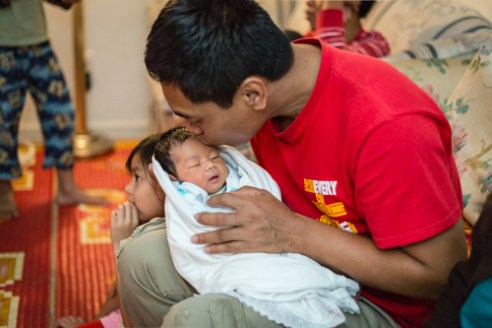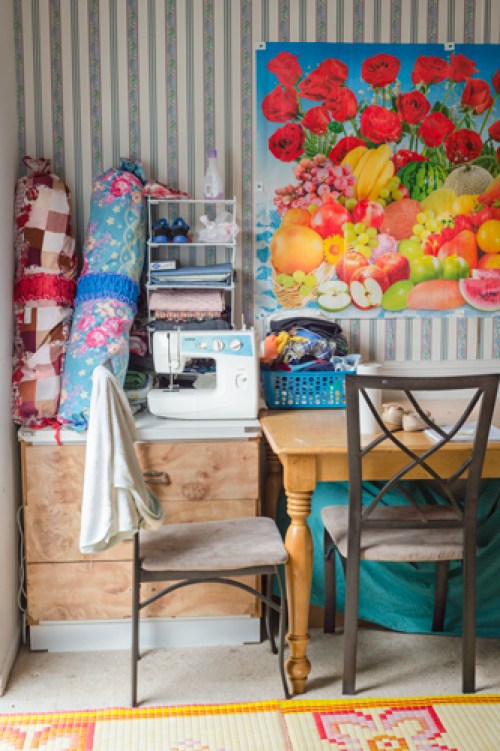Photographer Lorrie Dallek is the Edge of Humanity Magazine contributor of this documentary photography. From her project ‘New Americans ‘. To see Lorrie’s body of work click on any photograph.
My journey into the lives of the Sing-Hing family from Myanmar began almost four years ago at the AJC Decatur Book Festival. I was selling my photo book “The Women of Southeast Asia” when Daphne Hall, a teacher with the Global Village Project (GVP), a school for refugee girls, was drawn to my booth. She immediately recognized the women in the book. They were the same faces as the girls she was teaching here in the U.S. Daphne knew the girls at GVP would love to see images from their countries of origin, so she invited me to present a slide show. She cautioned me that the girls would most likely be quiet and shy as they were just beginning to learn English. This turned out to be far from the truth. The 32 girls attending the school just loved seeing their homeland and were actually quite raucous. This was the start of my involvement in Georgia’s refugee community as a volunteer. I began teaching a photo class at GVP. Two at a time, the girls were taught basic mechanics of camera use and composition. They were tasked with taking pictures at home and selecting one or two to create a story in English. This continued for several months with different pairs of girls rotating through the class.
As life would have it, one thing led to the next. I continued volunteering at GVP in different roles mostly utilizing my photography. And then I became a mentor to 11-year-old En Kawli, who had taken my photography class. Initially I focused on her educational and social needs. Over time I got to know her parents and siblings. As they came to trust me, I began to assume the role of advocate for the entire family. Each day was different. One day we were addressing a child’s educational needs, the next reviewing documents that arrived in the mail. They would ask me to lend an opinion on different matters that would arise.
My involvement with their struggles and triumphs became the subject of this photo essay, “Becoming American.” I spent nearly two years with the family before I picked up my camera. As time passed I learned how and why they came to the U.S.
The family’s journey began in the western part of Myanmar, previously known as Burma, in a very rural region called Chin State. Their ancestors had migrated to Myanmar hundreds of years ago from China. The Burmese government classified them as “ethnic minorities” and they were treated as second class citizens. Compounding their outcast status, they were raised Christian in a predominantly Buddhist country.
While in the Chin State, the family lived in huts without any modern facilities. There was no running water or flush toilets. They cooked over an open fire and had to raise all their food. The military sometimes abused them and forced them to work without pay.
En Kawli’s mother and father, Zil and Pai, met in school where they learned to read and write Burmese. As youngsters, they wanted to advance their education but it proved out of reach. That sowed the seed for their dream of education for their yet unborn children.
After they married, they lived for a while with Zil’s parents and started their family. Before long, the food they produced was not enough to feed their growing family. So Pai walked for two weeks to India where he found work in construction and sent money back home to care for his family. Eventually Zil joined him, leaving their four children behind in the care of her parents.
Zil and Pai remained in India without their children for several years, but they had a plan. They’d heard they could potentially leave Asia with the help of a resettlement agency. So Pai and Zil walked to Malaysia and saved enough money to send for their children. Escorted by”friends”, the children walked for two weeks across byways and through forest and rivers, evading authorities and wild animals along the way. The children still remember how scared and hungry they were during the journey.
The family finally was reunited in Malaysia. There Zil and Pai continued to work and save their money for three years. For the first time they lived in a conventional apartment building with running water, refrigeration and flush toilets. A man who lived in the same building taught the children rudimentary English and read them fables. During this time, a fifth child was born but tragically died.
After much paperwork, vetting and loans, the family was cleared to receive their green cards and become legal residents of the United States, their first choice for host country.
Airplane tickets were bought by the International Rescue Committee (IRC) resettlement agency; the family had to promise to reimburse the cost within a year.
They arrived in 2013 with the clothes on their back and did not speak functional English. But their dream was unbroken. Along with the IRC, the Baptist Burmese Chin church in Atlanta helped the family get settled in Clarkston, a community of 8,000 refugees. There they were surrounded by others just like themselves: confused, non-English speaking, traumatized, destitute people who left their extended families to flee persecution and the traumas of civil war.
As soon as they arrived, the children were enrolled in school, and Pai and Zil went to work. He got a job on the night shift at a poultry factory and she took a sewing class, which led to contract work. Today Zil also worked at a local Burmese owned variety story and tends a large vegetable garden behind their apartment complex to augment their food supply.
They are devout Baptists who attend church weekly and all of the children excel in school. Ram, 14, attends Fugee Academy. En Kawli, 16, goes to The New School in downtown Atlanta, Bawi, 12, recently tested “gifted” at Indian Creek Elementary and Mi Mi, 18, is a Junior at Clarkston High School where she excels in voice and violin. A year ago, the family welcomed a new child, Samuel, who brings much joy to everyone.
Like generations of immigrants who have preceded them, the Sing-Hing family came to the U.S. with the belief that through hard work they, too, could share in the American Dream. By American standards, they are still impoverished. Until recently, they live in a cramped two bedroom apartment, with four school-aged children sharing the same room.
But little by little, they have improved their lot. With-in the last month they actually purchased and moved into their own single-family home. It is truly a profound accomplishment. Within five years of coming to America they have achieved another piece of the American Dream. – home ownership
See also:
By Lorrie Dallek
![]()















